Ocean Surface Wind Field Retrieval Simultaneously Using SAR Backscatter and Doppler Shift Measurements
Abstract
1. Introduction
2. Materials
2.1. SAR Data
2.2. ERA5 Reanalysis Data
2.3. In Situ Wind Speed Data
3. Methodology
3.1. Extraction of Geophysical DCA Based on Sentinel-1 OCN Data
3.2. Direct Inversion Method
3.3. Variational Analysis Method (VAM)
3.3.1. VAM Wind Field Retrieval Method Considering Only SAR NRCS
3.3.2. VAM Wind Field Retrieval Method Considering Only SAR DCA
3.3.3. VAM Wind Field Retrieval Method Considering Both SAR NRCS and DCA
4. Results
4.1. SAR Geophysical DCA Correction
4.2. Wind Field Retrieval
4.3. ERA5 Wind Speed Correction and Its Impact on the Accuracy of VAM
5. Discussion
6. Conclusions
Author Contributions
Funding
Data Availability Statement
Acknowledgments
Conflicts of Interest
References
- Elyouncha, A.; Eriksson, L.E.B.; Broström, G.; Axell, L.; Ulander, L.H.M. Joint retrieval of ocean surface wind and current vectors from satellite SAR data using a Bayesian inversion method. Remote Sens. Environ. 2021, 260, 112455. [Google Scholar] [CrossRef]
- Sun, J.; Li, H.; Lin, W.; He, Y. Joint Inversion of Sea Surface Wind and Current Velocity Based on Sentinel-1 Synthetic Aperture Radar Observations. J. Mar. Sci. Eng. 2024, 12, 450. [Google Scholar] [CrossRef]
- Colmenar-Santos, A.; Perera-Perez, J.; Borge-Diez, D.; de Palacio-Rodríguez, C. Offshore wind energy: A review of the current status, challenges and future development in Spain. Renew. Sustain. Energy Rev. 2016, 64, 1–18. [Google Scholar] [CrossRef]
- Kim, T.H.; Yang, C.S.; Oh, J.H.; Ouchi, K. Analysis of the contribution of wind drift factor to oil slick movement under strong tidal condition: Hebei Spirit oil spill case. PLoS ONE 2014, 9, e87393. [Google Scholar] [CrossRef]
- Fang, H.; Xie, T.; Perrie, W.; Zhang, G.; Yang, J.; He, Y. Comparison of C-Band Quad-Polarization Synthetic Aperture Radar Wind Retrieval Models. Remote Sens. 2018, 10, 1448. [Google Scholar] [CrossRef]
- Zamparelli, V.; De Santi, F.; De Carolis, G.; Fornaro, G. SAR Based Sea Surface Complex Wind Fields Estimation: An Analysis over the Northern Adriatic Sea. Remote Sens. 2023, 15, 2074. [Google Scholar] [CrossRef]
- Lin, H.; Xu, Q.; Zheng, Q. An overview on SAR measurements of sea surface wind. Prog. Nat. Sci. Mater. Int. 2008, 18, 913–919. [Google Scholar] [CrossRef]
- Wang, Y.; Li, Y.; Xie, Y.; Wei, G.; He, Z.; Geng, X.; Shang, S. Assessment of Sea-Surface Wind Retrieval from C-Band Miniaturized SAR Imagery. Sensors 2023, 23, 6313. [Google Scholar] [CrossRef]
- Zhao, Y.; Li, X.M.; Sha, J. Sea surface wind streaks in spaceborne synthetic aperture radar imagery. J. Geophys. Res. Ocean 2016, 121, 6731–6741. [Google Scholar] [CrossRef]
- Portabella, M.; Stoffelen, A.; Johannessen, J.A. Toward an optimal inversion method for synthetic aperture radar wind retrieval. J. Geophys. Res. Ocean 2002, 107, 1-1–1-13. [Google Scholar] [CrossRef]
- Ren, L.; Yang, J.; Mouche, A.A.; Wang, H.; Zheng, G.; Wang, J.; Zhang, H.; Lou, X.; Chen, P. Assessments of Ocean Wind Retrieval Schemes Used for Chinese Gaofen-3 Synthetic Aperture Radar Co-Polarized Data. IEEE Trans. Geosci. Remote Sens. 2019, 57, 7075–7085. [Google Scholar] [CrossRef]
- Romeiser, R.; Thompson, D.R. Numerical study on the along-track interferometric radar imaging mechanism of oceanic surface currents. IEEE Trans. Geosci. Remote Sens. 2000, 38, 446–458. [Google Scholar] [CrossRef]
- Chapron, B.; Collard, F.; Ardhuin, F. Direct measurements of ocean surface velocity from space: Interpretation and validation. J. Geophys. Res. Ocean 2005, 110, 17. [Google Scholar] [CrossRef]
- Mouche, A.A.; Collard, F.; Chapron, B.; Dagestad, K.-F.; Guitton, G.; Johannessen, J.A.; Kerbaol, V.; Hansen, M.W. On the Use of Doppler Shift for Sea Surface Wind Retrieval from SAR. IEEE Trans. Geosci. Remote Sens. 2012, 50, 2901–2909. [Google Scholar] [CrossRef]
- Mouche, A.A.; Chapron, B.; Zhang, B.; Husson, R. Combined Co- and Cross-Polarized SAR Measurements Under Extreme Wind Conditions. IEEE Trans. Geosci. Remote Sens. 2017, 55, 6746–6755. [Google Scholar] [CrossRef]
- Engen, G.; Johnsen, H. Sentinel-1 Doppler and Ocean Radial Velocity Algorithm Definition; Northern Research Institute: Tromsø, Norway, 2011; p. 59. [Google Scholar]
- Hersbach, H. CMOD5.N: A C-Band Geophysical Model Function for Equivalent Neutral Wind; ECMWF: Reading, UK, 2008; pp. 1–22. [Google Scholar]
- Liu, W.T.; Tang, W. Equivalent Neutral Wind. J. Phys. Oceanogr. 1996. [Google Scholar]
- Kara, A.B.; Wallcraft, A.J.; Bourassa, M.A. Air-sea stability effects on the 10 m winds over the global ocean: Evaluations of air-sea flux algorithms. J. Geophys. Res. Ocean. 2008, 113. [Google Scholar] [CrossRef]
- Ali, M.M.; Bhat, G.S.; Long, D.G.; Bharadwaj, S.; Bourassa, M.A. Estimating Wind Stress at the Ocean Surface From Scatterometer Observations. IEEE Geosci. Remote Sens. Lett. 2013, 10, 1129–1132. [Google Scholar] [CrossRef]
- Foken, T. 50 Years of the Monin–Obukhov Similarity Theory. Bound.-Layer Meteorol. 2006, 119, 431–447. [Google Scholar] [CrossRef]
- Wilson, J.D. Monin-Obukhov Functions for Standard Deviations of Velocity. Bound.-Layer Meteorol. 2008, 129, 353–369. [Google Scholar] [CrossRef]
- Charnock, H. Wind stress on a water surface. Q. J. R. Meteorol. Soc. 1955, 81, 639–640. [Google Scholar] [CrossRef]
- Smith, S.D. Coefficients for sea surface wind stress, heat flux, and wind profiles as a function of wind speed and temperature. J. Geophys. Res. Ocean 1988, 93, 15467–15472. [Google Scholar] [CrossRef]
- Hansen, M.W.; Collard, F.; Dagestad, K.-F.; Johannessen, J.A.; Fabry, P.; Chapron, B. Retrieval of Sea Surface Range Velocities from Envisat ASAR Doppler Centroid Measurements. IEEE Trans. Geosci. Remote Sens. 2011, 49, 3582–3592. [Google Scholar] [CrossRef]
- Johnsen, H.; Nilsen, V.; Engen, G.; Mouche, A.A.; Collard, F. Ocean doppler anomaly and ocean surface current from Sentinel 1 tops mode. In Proceedings of the 2016 IEEE International Geoscience and Remote Sensing Symposium (IGARSS), Beijing, China, 10–15 July 2016; pp. 3993–3996. [Google Scholar]
- Gao, F.; Huang, X.-Y.; Jacobs, N.A.; Wang, H. Assimilation of wind speed and direction observations: Results from real observation experiments. Tellus A Dyn. Meteorol. Oceanogr. 2015, 67, 27132. [Google Scholar] [CrossRef]
- Yu, Y.; Yang, X.; Zhang, W.; Duan, B.; Cao, X.; Leng, H. Assimilation of Sentinel-1 Derived Sea Surface Winds for Typhoon Forecasting. Remote Sens. 2017, 9, 845. [Google Scholar] [CrossRef]
- Zhang, K.; Huang, J.; Xu, X.; Guo, Q.; Chen, Y.; Mansaray, L.R.; Li, Z.; Wang, X. Spatial Scale Effect on Wind Speed Retrieval Accuracy Using Sentinel-1 Copolarization SAR. IEEE Geosci. Remote Sens. Lett. 2018, 15, 882–886. [Google Scholar] [CrossRef]
- Alkhalidi, M.; Al-Dabbous, A.; Al-Dabbous, S.; Alzaid, D. Evaluating the Accuracy of the ERA5 Model in Predicting Wind Speeds Across Coastal and Offshore Regions. J. Mar. Sci. Eng. 2025, 13, 149. [Google Scholar] [CrossRef]
- Chen, T.C.; Collet, F.; Di Luca, A. Evaluation of ERA5 precipitation and 10-m wind speed associated with extratropical cyclones using station data over North America. Int. J. Climatol. 2024, 44, 729–747. [Google Scholar] [CrossRef]


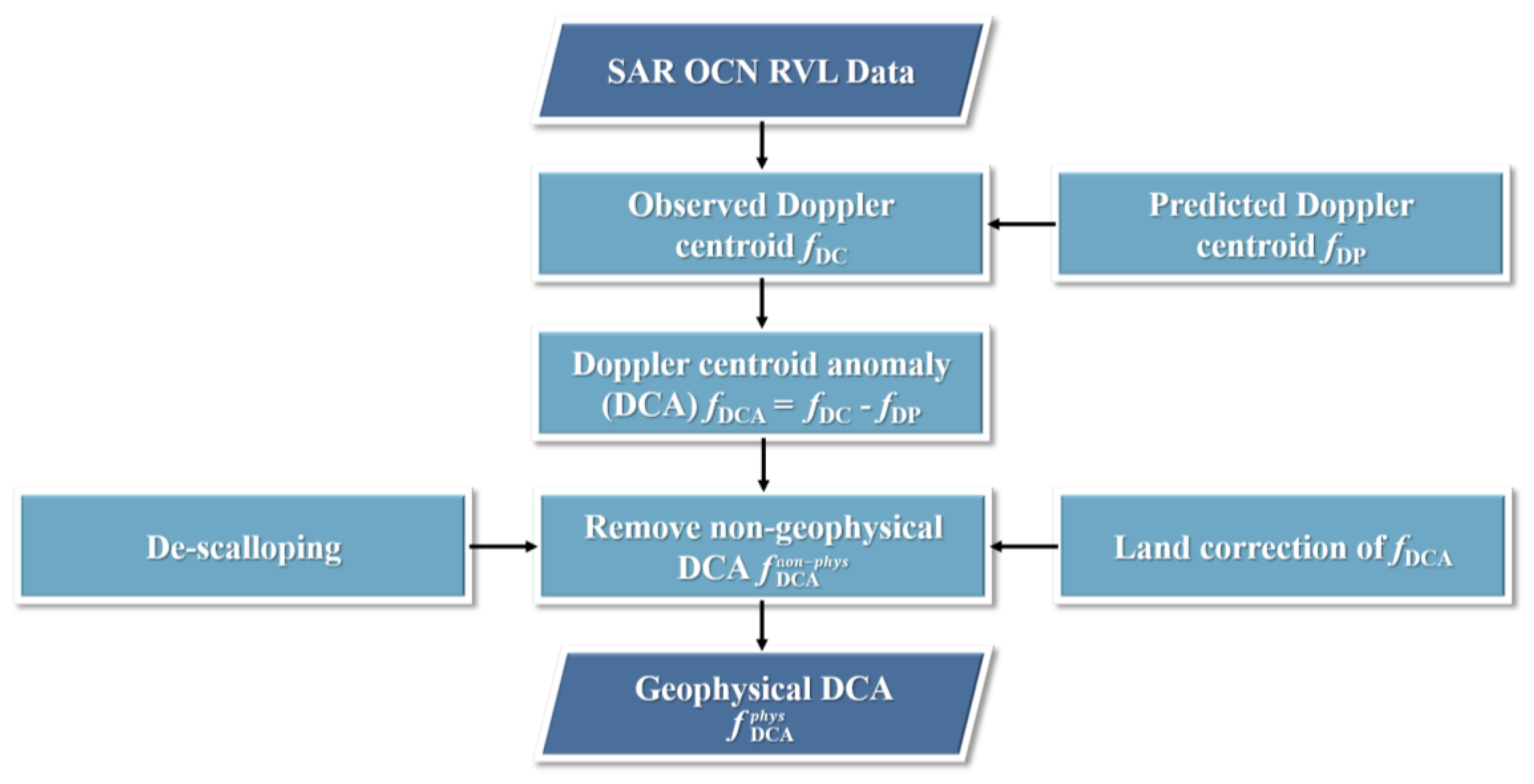
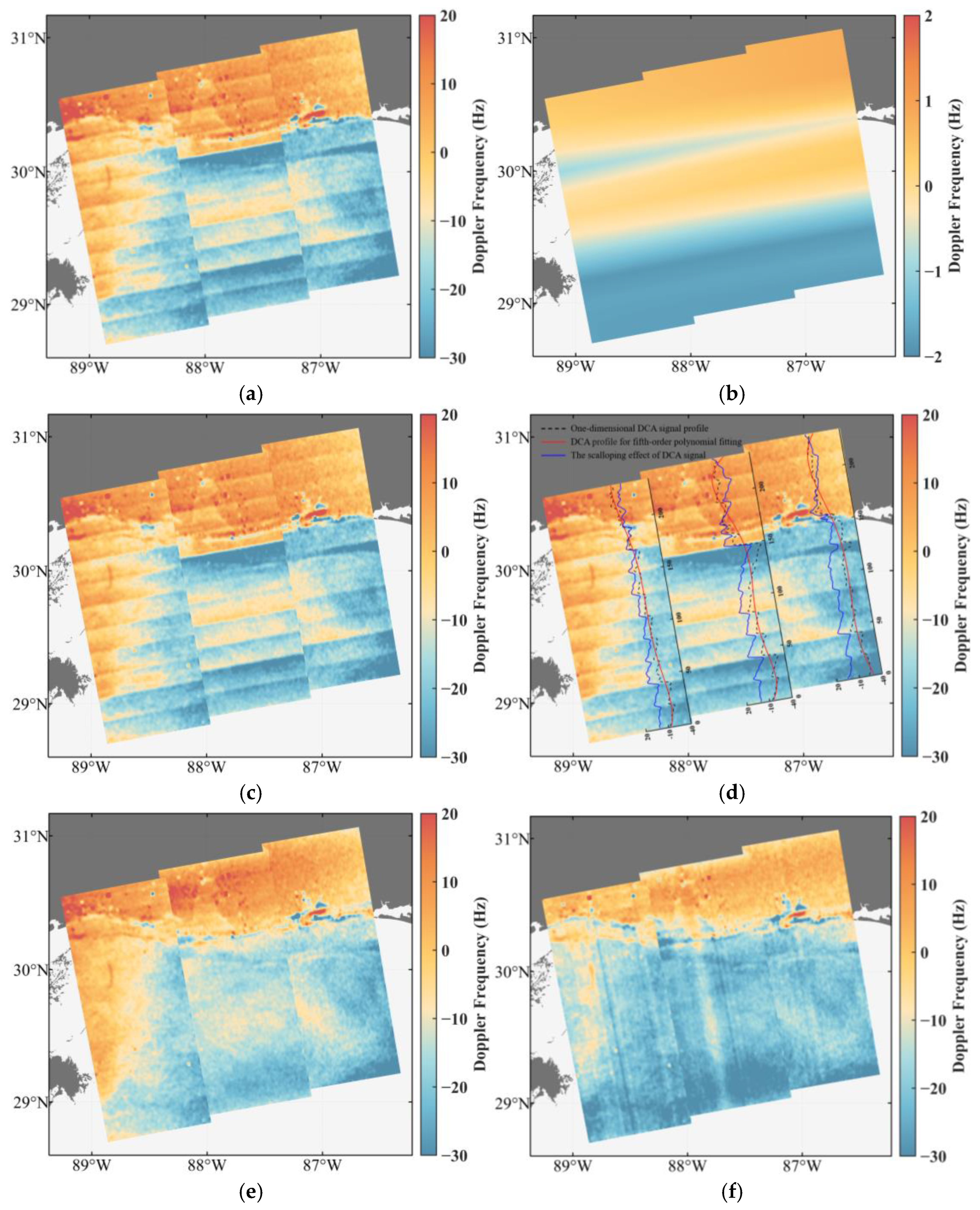
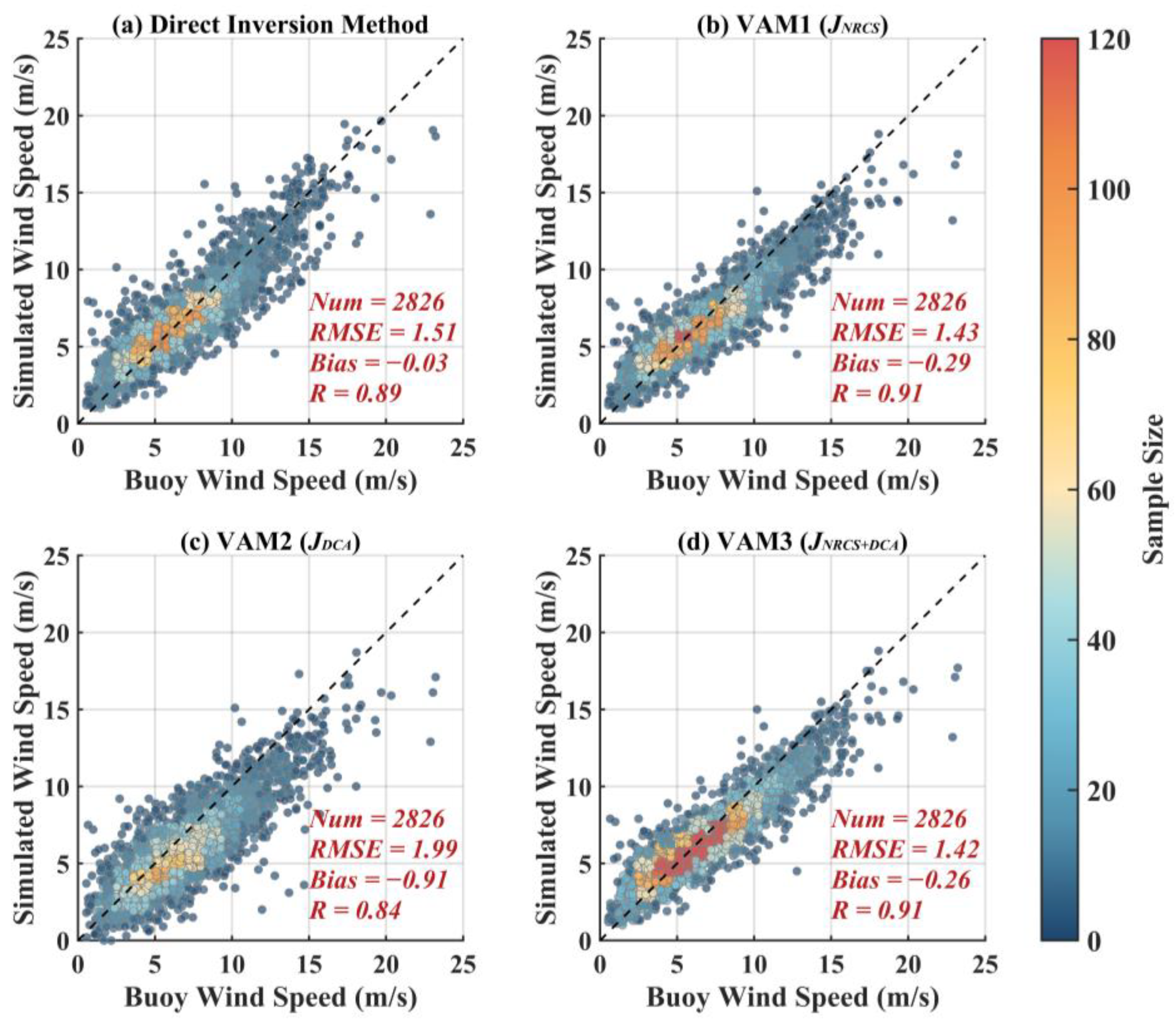
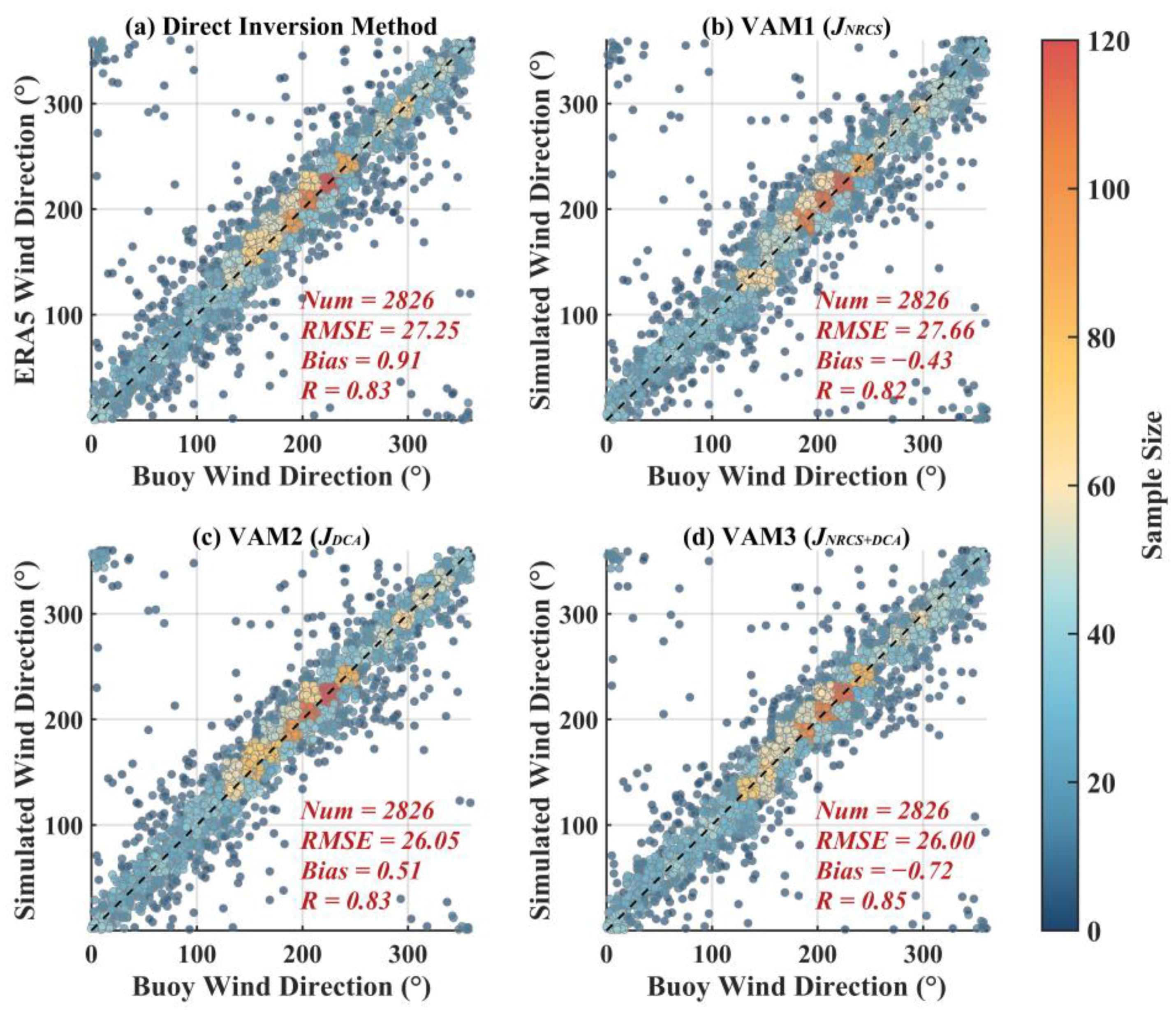
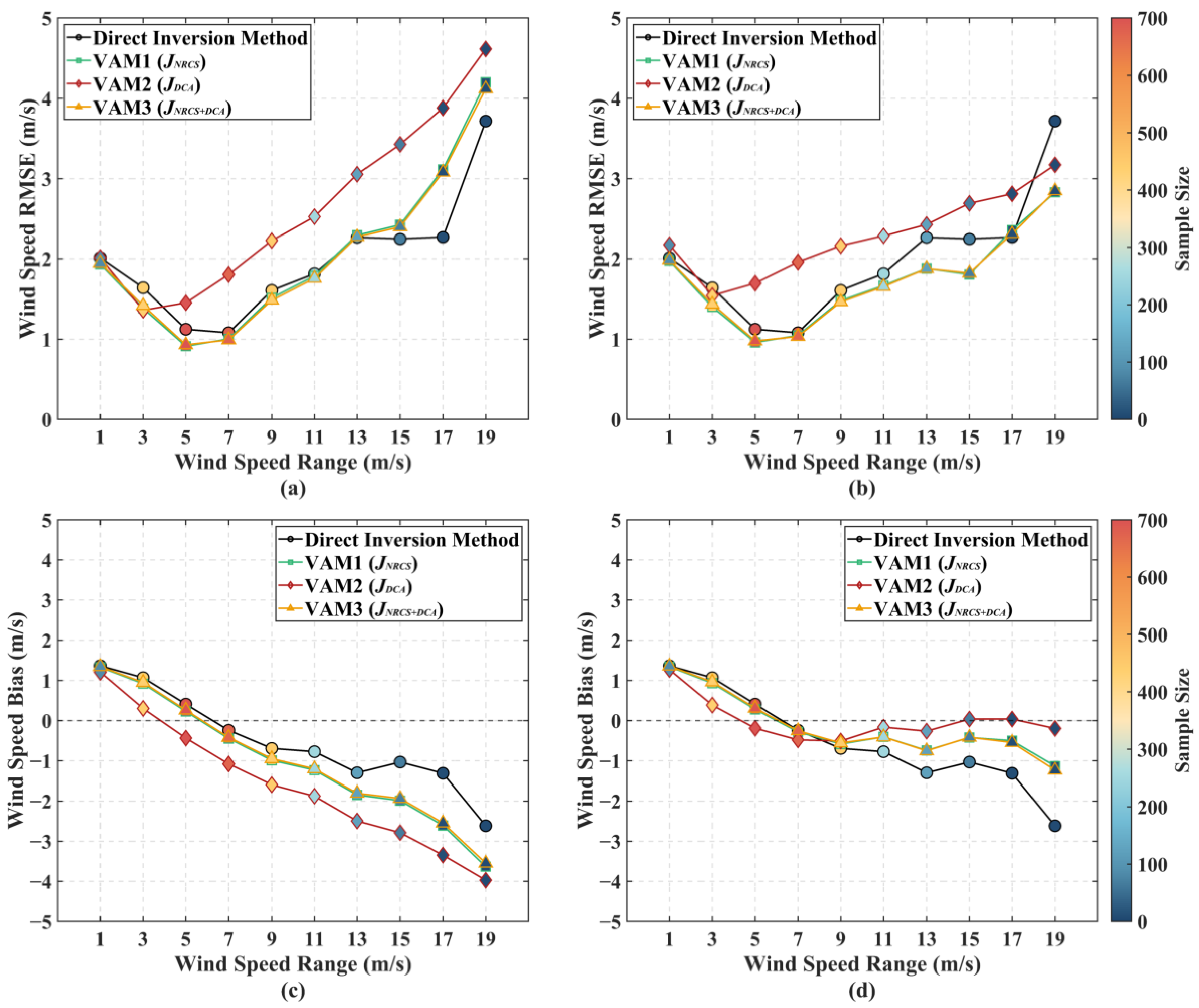
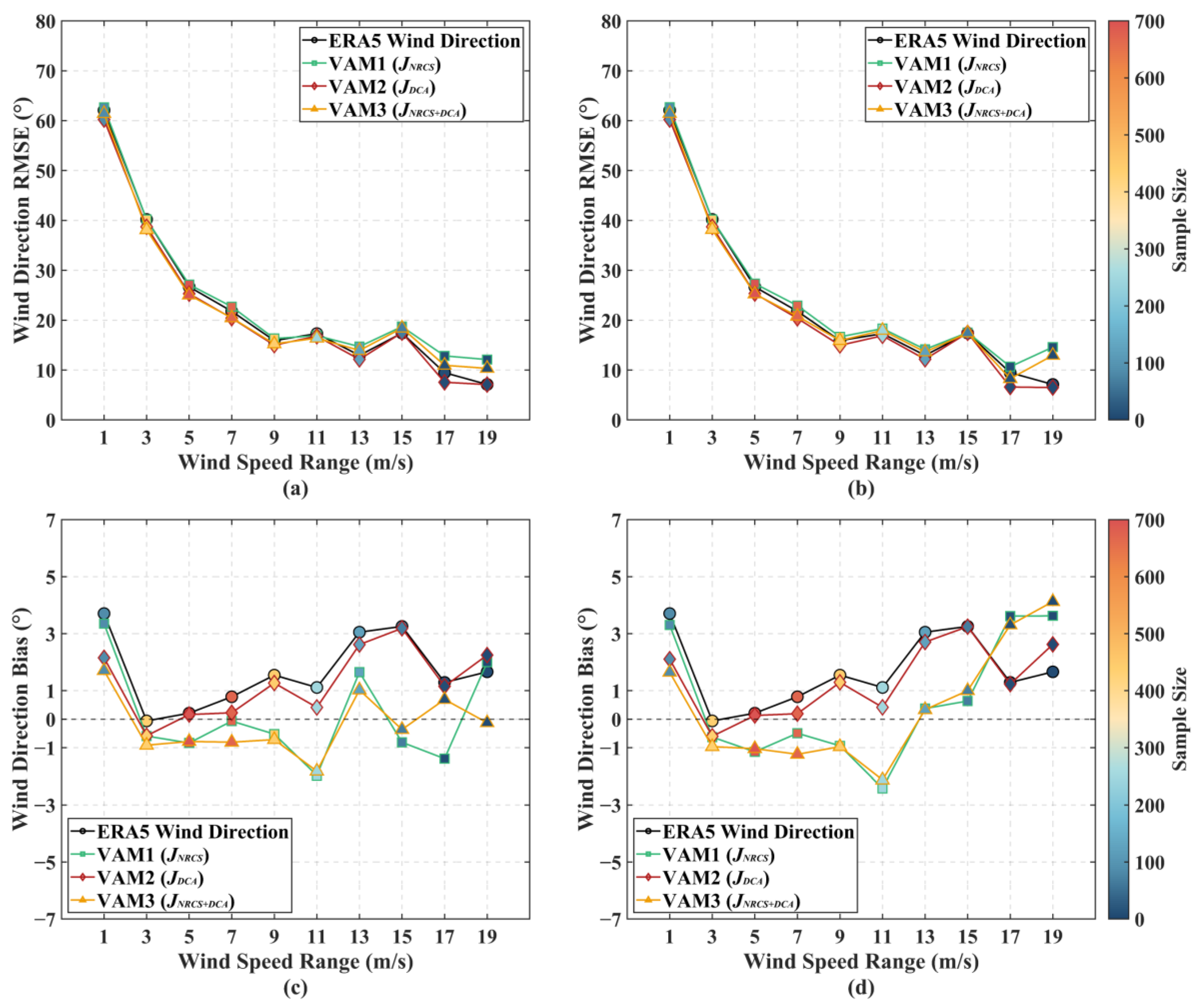
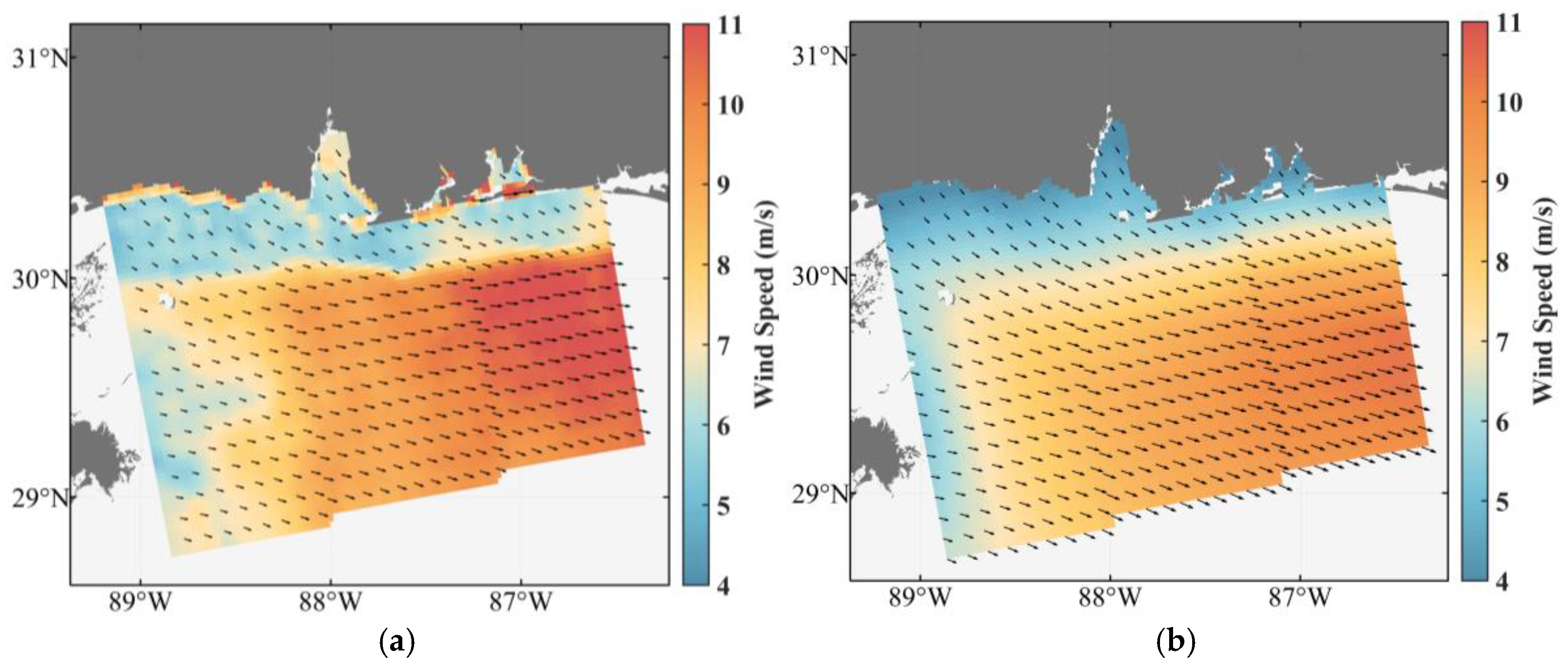
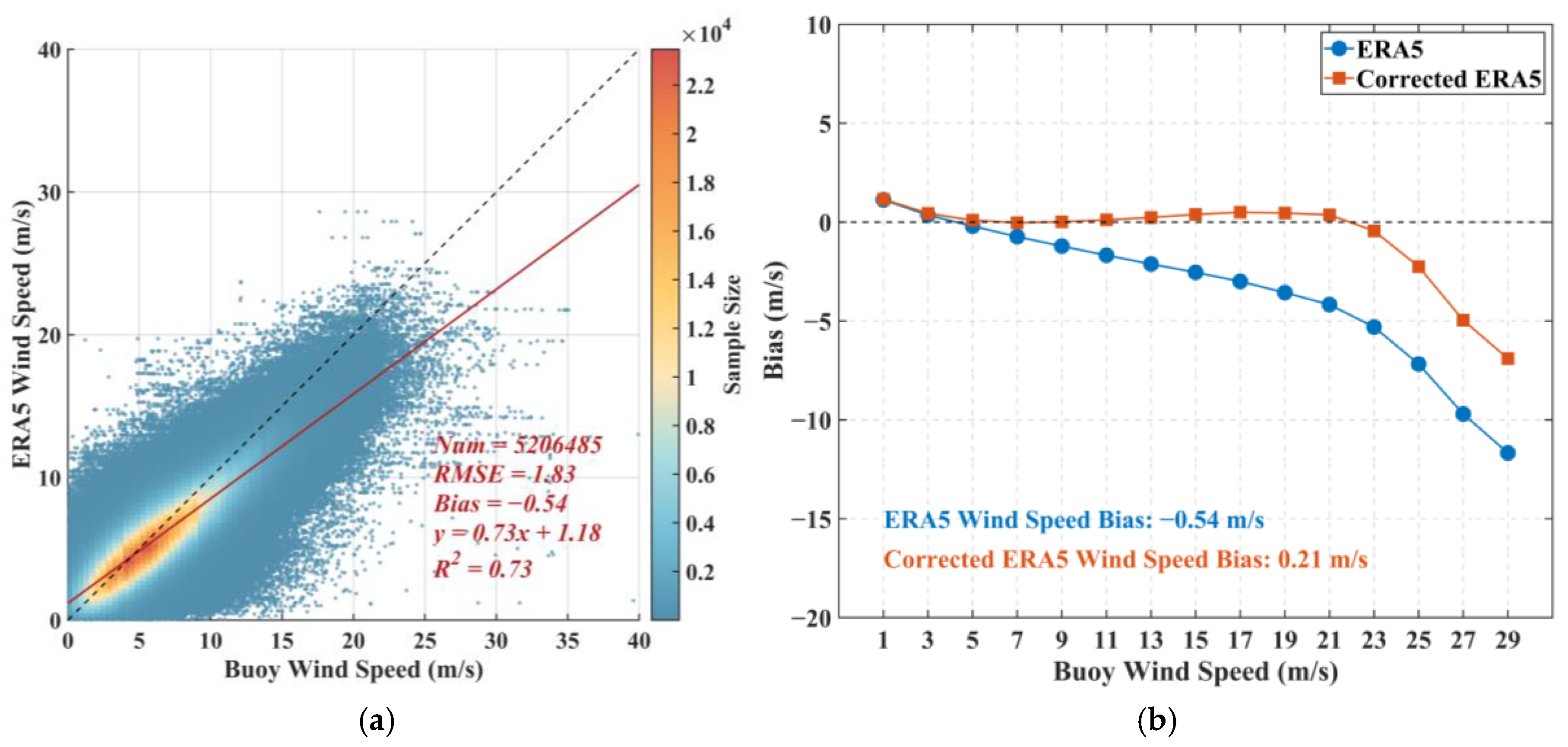
| Parameters | SM | IW | EW | WV |
|---|---|---|---|---|
| Polarization mode | HH, VV, HH + HV, VV + VH | HH, VV | ||
| Angle of incidence | 18.3–46.8° | 29.1–46.0° | 18.9–47.0° | 21.6–25.1° 34.8–38.0° |
| Azimuth resolution | 5 m | 20 m | 40 m | 5 m |
| Distance resolution | 5 m | 5 m | 20 m | 5 m |
| Swath width | 80 km | 250 km | 400 km | 20 km |
Disclaimer/Publisher’s Note: The statements, opinions and data contained in all publications are solely those of the individual author(s) and contributor(s) and not of MDPI and/or the editor(s). MDPI and/or the editor(s) disclaim responsibility for any injury to people or property resulting from any ideas, methods, instructions or products referred to in the content. |
© 2025 by the authors. Licensee MDPI, Basel, Switzerland. This article is an open access article distributed under the terms and conditions of the Creative Commons Attribution (CC BY) license (https://creativecommons.org/licenses/by/4.0/).
Share and Cite
Xu, Y.; Zhang, K.; Jing, L.; Zhang, B.; Fan, S.; Fang, H. Ocean Surface Wind Field Retrieval Simultaneously Using SAR Backscatter and Doppler Shift Measurements. Remote Sens. 2025, 17, 1742. https://doi.org/10.3390/rs17101742
Xu Y, Zhang K, Jing L, Zhang B, Fan S, Fang H. Ocean Surface Wind Field Retrieval Simultaneously Using SAR Backscatter and Doppler Shift Measurements. Remote Sensing. 2025; 17(10):1742. https://doi.org/10.3390/rs17101742
Chicago/Turabian StyleXu, Yulei, Kangyu Zhang, Liwei Jing, Biao Zhang, Shengren Fan, and He Fang. 2025. "Ocean Surface Wind Field Retrieval Simultaneously Using SAR Backscatter and Doppler Shift Measurements" Remote Sensing 17, no. 10: 1742. https://doi.org/10.3390/rs17101742
APA StyleXu, Y., Zhang, K., Jing, L., Zhang, B., Fan, S., & Fang, H. (2025). Ocean Surface Wind Field Retrieval Simultaneously Using SAR Backscatter and Doppler Shift Measurements. Remote Sensing, 17(10), 1742. https://doi.org/10.3390/rs17101742







